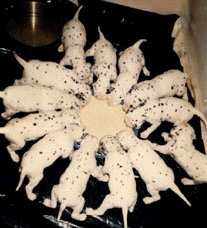The site was last updated on
24 Aug 2000

|
What is Puppyhood?
Puppyhood is the period when your dog is
immature, physically, mentally and emotionally. It lasts until he reaches
adulthood at about 24 months, although this can be even later in some large
breeds. Here’s what to expect in those 24 months, and how to bring out the
best in your pup.
Day 1 to 6 weeks
A pup needs his mother’s care and
the company of his littermates. At four weeks, he needs about 10 minutes a day
outside the puppy pen, being handled by a human to develop his individuality. At
around six weeks, he will start to learn about his pack place in the pack
pecking order. Mom teaches him to respect authority, which will make him more
trainable later. Roughhousing with his brothers and sisters makes him less
sensitive to body contact and noise, teaches him to behave socially in the pooch
world, and also to keep his aggression in check.
7 to 8 weeks
This is the ideal age for a pup to
move into your home and start finding out what goes on beyond the puppy pen.
After he has had his temporary immunizations, take you pup to all sorts of
places. Put him down, walk away and let him follow you. This will teach him that
you’re the leader of his pack and he’s a faithful follower. Set up
situations where he can follow every family member, including the kids. This is
the critical time for human socialization, it won’t come again, don’t miss
it.Puppies this age can learn what simple commands such as “Sit” and “Come” mean. You can also start gentle leash training. But these lessons can wait a week or two, if necessary.
8 to 10 weeks
More than anything, your puppy needs
to feel secure right now. This is the ‘fear imprint period’, when puppies
can easily be traumatize and may never forget what frightened them. Some pups
are more affected than others, but this is not a good time to take your puppy to
a rock concert in the park.At this age, puppies love to learn, as long as the teaching is gentle and consistent. Knowing how to please you by coming when called will bolster his confidence, and sticking to a schedule will also make him feel safe. Continue socializing him: eight weeks is the ideal time to enrol him in puppy-training classes.
10 to 12 weeks
Now’s the time to add your pup’s
social activities and continue gentle training. If he has not been leash trained
or learned his puppy ‘Sit’ and ‘Come’, start now. He should accompany
you to new places, both indoor and outdoor, meet friendly people of all ages,
other puppies and gentle adult dogs.
12 to 16 weeks
During these weeks, your bundle of fun
will continue to need a heap of attention and plenty of social activities. Keep
up the training with your puppy, but be gentle. Some pups go through an
“avoidance” period at this age, peeping from behind your legs when you go
out, or crawling under the couch when company arrives. If he’s been okay
around people and other dogs until now, his shyness will probably be
short-lived. Keep his social life low-key but regular for a while if he keeps
hiding.
16 weeks to 6 months
The juvenile begins at 16 weeks. While
your puppy is fully developed mentally, he still has some physical and emotional
growing to do, and he won’t have an adult attention span. The name of the game
is consistency---keep your expectations the same from day to day so he doesn’t
get confused. Take him out to meet humans and other dogs, and have short, upbeat
training sessions. Integrate training into everyday life, for example, by having
him sit while you prepare his dinner. He may be clumsy now, but that’s just
adolescence. He’ll be graceful when he’s grown.
6 to 12 months
Your puppy reaches puberty, or sexual
maturity, during these months, and male youngsters may try out being pushy,
you’ll notice that your pooch’s attention span has improved. Training of
some kind should be ongoing, whether it’s for obedience or just tricks for
fun. Some dogs are through a second avoidance period at around ten months of
age, but they are usually happy-go-lucky again by one year old.
12 to 24 months
This is when your youngster becomes an
adult, although some dogs won’t reach emotional maturity until they are about
30 months old. Congratulations to you both!
